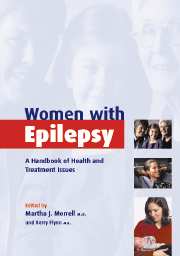Book contents
- Frontmatter
- Contents
- List of contributors
- Part I The woman with epilepsy
- Part II Epilepsy diagnosis and treatment
- Part III Hormones and the brain
- Part IV Health challenges for women with epilepsy
- Part V Family planning, pregnancy, and parenting
- 18 Family planning and contraceptive choice
- 19 Pregnancy risks for the woman with epilepsy
- 20 Risks of birth defects in children born to mothers with epilepsy
- 21 Neurocognitive outcome in children of mothers with epilepsy
- 22 Parenting for women with epilepsy
- Part VI Living well with epilepsy
- Appendix: The Epilepsy Foundation's Campaign for Women's Health: bringing help and hope to women with epilepsy
- Index
18 - Family planning and contraceptive choice
from Part V - Family planning, pregnancy, and parenting
Published online by Cambridge University Press: 02 November 2009
- Frontmatter
- Contents
- List of contributors
- Part I The woman with epilepsy
- Part II Epilepsy diagnosis and treatment
- Part III Hormones and the brain
- Part IV Health challenges for women with epilepsy
- Part V Family planning, pregnancy, and parenting
- 18 Family planning and contraceptive choice
- 19 Pregnancy risks for the woman with epilepsy
- 20 Risks of birth defects in children born to mothers with epilepsy
- 21 Neurocognitive outcome in children of mothers with epilepsy
- 22 Parenting for women with epilepsy
- Part VI Living well with epilepsy
- Appendix: The Epilepsy Foundation's Campaign for Women's Health: bringing help and hope to women with epilepsy
- Index
Summary
Many women assume that they will have the opportunity to decide whether, and when, to have a child. Modern forms of contraceptives provide safe and effective birth control. The most popular form of contraceptive is the birth control pill. Introduced in the 1960s, these hormone-containing products rapidly became one of the preferred forms of family planning. Initial concerns that the estrogen hormones in these pills increased the risk for blood clotting and stroke led to the development of pills that contained very low doses of hormones. These products may lessen the very small risk of side effects, and the dose of hormone is no more than is absolutely necessary to stop ovulation.
In the 1980s physicians began to notice that women with epilepsy taking antiepileptic drugs and using birth control pills had more unplanned pregnancies than expected. Only one out of 100 women using birth control pills become pregnant each year – most by forgetting to take the pill on one or several days. However, women with epilepsy taking antiepileptic drugs had six or more failures per year per 100 women. Physicians quickly realized that some antiepileptic drugs increased the breakdown of the hormones contained within the birth control pill. Women were subsequently counseled that birth control pills could not be used safely when taking particular antiepileptic drugs. Unfortunately, many physicians still do not know about this interaction.
In this chapter, Dr Pamela Crawford reviews this complex and important topic. She stresses that each woman must know whether her medical therapy can interfere with hormonal contraception.[…]
Keywords
- Type
- Chapter
- Information
- Women with EpilepsyA Handbook of Health and Treatment Issues, pp. 197 - 202Publisher: Cambridge University PressPrint publication year: 2003
- 1
- Cited by



